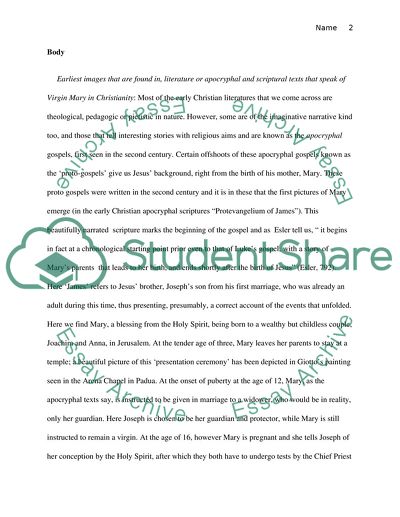Cite this document
(Earliest Images and Initial Understandings of the Virgin Mary in Chris Essay, n.d.)
Earliest Images and Initial Understandings of the Virgin Mary in Chris Essay. Retrieved from https://studentshare.org/history/1733259-question-1-discuss-the-earliest-images-in-art-literature-or-apocryphal-and-scriptural-texts-of-mary-in-christianity-consider-how-the-earliest-christians-came-to-their-initial-understandings-of-who-mary-was-in-both-their-daily-faith-experiences-and
Earliest Images and Initial Understandings of the Virgin Mary in Chris Essay. Retrieved from https://studentshare.org/history/1733259-question-1-discuss-the-earliest-images-in-art-literature-or-apocryphal-and-scriptural-texts-of-mary-in-christianity-consider-how-the-earliest-christians-came-to-their-initial-understandings-of-who-mary-was-in-both-their-daily-faith-experiences-and
(Earliest Images and Initial Understandings of the Virgin Mary in Chris Essay)
Earliest Images and Initial Understandings of the Virgin Mary in Chris Essay. https://studentshare.org/history/1733259-question-1-discuss-the-earliest-images-in-art-literature-or-apocryphal-and-scriptural-texts-of-mary-in-christianity-consider-how-the-earliest-christians-came-to-their-initial-understandings-of-who-mary-was-in-both-their-daily-faith-experiences-and.
Earliest Images and Initial Understandings of the Virgin Mary in Chris Essay. https://studentshare.org/history/1733259-question-1-discuss-the-earliest-images-in-art-literature-or-apocryphal-and-scriptural-texts-of-mary-in-christianity-consider-how-the-earliest-christians-came-to-their-initial-understandings-of-who-mary-was-in-both-their-daily-faith-experiences-and.
“Earliest Images and Initial Understandings of the Virgin Mary in Chris Essay”, n.d. https://studentshare.org/history/1733259-question-1-discuss-the-earliest-images-in-art-literature-or-apocryphal-and-scriptural-texts-of-mary-in-christianity-consider-how-the-earliest-christians-came-to-their-initial-understandings-of-who-mary-was-in-both-their-daily-faith-experiences-and.


